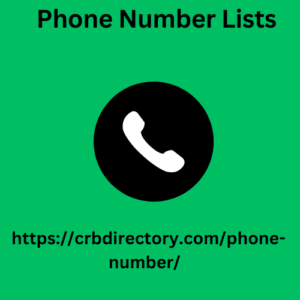Creating a new database can seem daunting, but using a template can simplify the process significantly. One of the most versatile and user-friendly templates available is the Contacts Database Template. This guide will walk you through the steps to create a new database using this template, helping you manage your contacts efficiently and effectively.
Why Use a Contacts Database Template?
A Contacts Database Template offers a pre Benefits of Phone Number Lists -structured. How to Create a New format that makes it easy to organize and retrieve information. Whether you are managing business contacts, personal connections, or customer details, a well-organized database ensures you have the necessary information at your fingertips. Here are some reasons to consider using a Contacts Database Template:
- Time-Saving: Pre-defined fields and layouts save time on setup.
- Consistency: Standardized fields ensure consistent data entry.
- Ease of Use: User-friendly interfaces simplify navigation and management.
- Scalability: Easily expand the database as your contact list grows.
Steps to Create a New Database Using the Contacts Database Template
Step 1: Choose Your Database Management System (DBMS)
Before you begin, select a database management system that suits your needs. Popular options include Microsoft Access, MySQL, and SQLite. For this guide, we will use Microsoft Access, known for its user-friendly interface and robust features.
Step 2: Access the Template
Microsoft Access provides several templates, including the Contacts Database Template. Here’s how to find and use it:
- Open Microsoft Access: Launch the application.
- Search for the Template: In the search bar, type “Contacts” and press Enter.
- Select the Template: Find the Contacts Database Template from the list and click on it.
- Create the Database: Click on the “Create” button to generate a new database based on the template.
Step 3: Customize the Database How to Create a New
Once the template is loaded, you can customize it to fit your specific needs:
- Add/Remove Fields: Modify existing fields or add new ones to capture all necessary information.
- Form Design: Customize forms to ensure easy data entry and retrieval.
- Reports: Generate reports that provide insights into your contact data.
- Navigation Pane: Organize the navigation pane for easy access to different sections of your database.
Step 4: Enter Data
With your template customized, start entering Beyond Static Orders: Unveiling the Power of Contact Form Databases for Magento Stores your contact information. Use the forms provided in the template for easy and consistent data entry. Ensure that you fill in all relevant fields to maximize the effectiveness of your database.
Step 5: Set Up Queries
Queries are powerful tools for filtering and retrieving specific information from your database. Set up queries to find contacts based on criteria such as location, industry, or last contact date. This will help you manage your interactions more effectively.
Step 6: Maintain and Update
Regularly update your database to keep information current. Remove outdated contacts and add new ones as necessary. Periodic maintenance ensures your database remains a valuable resource.
Tips for Effective Database Management How to Create a New
- Regular Backups: Ensure you regularly back up your database to prevent data loss.
- Data Validation: Implement data validation rules to maintain data quality.
- User Permissions: Set user permissions to control access and ensure data security.
- Training: Provide training for users to ensure they can effectively use the database.
Conclusion
Creating a new database using the Contacts Database Template is a straightforward process that can significantly enhance your ability to manage and organize contact information. By following the steps outlined in this guide, you can set up a customized, efficient, and scalable contacts database that meets your specific needs. Whether for business or personal use, a well-structured database will save you time, improve data accuracy, and facilitate better communication and relationship management.


